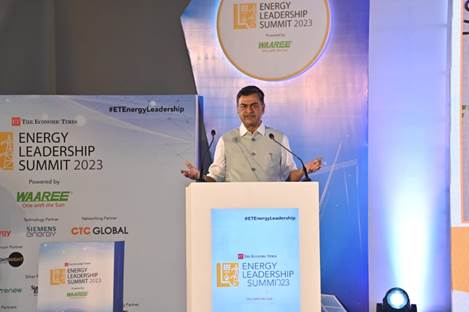TBB BUREAU
NEW DELHI, JUNE 20, 2023
Underlining the need to move to Net Zero and not a low-carbon future, the Union Minister for Power and New & Renewable Energy RK Singh on Tuesday said that “we cannot afford to add any more carbon dioxide to the atmosphere”.
Addressing “The Economic Times” Energy Leadership Summit & Awards event in New Delhi today, the Minister said that India’s per capita carbon emission is around 2 tons while the world per capita average is around 6 tons. India’s historical contribution to global emissions has been only 4% despite being the fifth largest economy and home to 17% of world’s population. “We look at the need for energy transition because the government believes in the need for leaving a healthier planet for future generations,” he said.

The Minister said that the Government of India has been working tirelessly on energy access, energy efficiency, energy sustainability and energy security, the four pillars of India’s future in the energy sector.
Since renewable energy storage is expensive, the government has come out with a policy to encourage Pumped Hydro Power Projects. “Huge capacities of Pumped Hydro projects are coming up. At the same time, we need to build batteries for grid storage. We need to have another PLI scheme for grid scale storage, so that we can augment capacity and have round-the-clock renewable energy. We will keep adding storage to ensure that demand goes up and investment keeps happening,” said Singh.
The Union Minister said that the nation set huge targets in renewable energy. “Today, 42% of our energy capacity is from non-fossil-fuels. We have made a commitment to take this to 50% by 2030, but we shall achieve 65% of capacity from non-fossil-fuels by 2030. We will add 50 GW of capacity every year. We have emerged as the fastest growing renewable energy destination.” Singh however stated that even as we build renewable energy capacity at the fastest rate, we will not shy away from adding the thermal capacity we may need in order to meet our energy requirements. “Our pace of energy transition will be the fastest in the world, but we will not compromise with our energy needs. In 2030, I see the capacity crossing 800 GW, and that is at a conservative rate of growth.”
The Minister said that the Indian economy will keep growing at the current rate for 2-3 decades, and that we will keep meeting our energy needs to ensure this growth. We are adding more and more charging stations, we want to reduce dependence on foreign sources of energy, said the Minister.
He underlined the need to prioritize green hydrogen for the country. “We need to reduce importing coal for blending. We need to strengthen our logistics from coal-bearing areas and also exploit our coal reserves, for which we are auctioning coal blocks so that our dependence on imports reduces. Our feed stock too has to transition, for which green hydrogen is a priority area and a huge opportunity. We have set a target of setting up at least 5 million tons of green hydrogen by the year 2030.”
The Minister also underlined the need for diversification of supply chains, using technologies such as sodium ion. He said that around 100 GW of battery storage capacity is going to come up in the coming years, out of which around 50 GW will be available for exports.
The Minister said that from 2014 onwards, India has added total power generation capacity of over 184 GW and that total installed capacity is 417 GW, while peak demand has reached 221 GW. “Peak demand has accelerated in the recent past, and it will continue to increase, but we have sufficient established capacity as of now.” The Power Minister informed that availability of power in rural areas went up to 22.5 hours and in urban areas to 23.5 hours. We aim to make it 24 hours,” he added.
The Power Minister stressed that from 2013 till date, the nation has added more than 1.8 lakh circuit kilometres of transmission lines, thereby connecting the entire country to a single grid that runs on one frequency with One National Control Centre. The inter-regional capacity added in the last 8 years is 74,300 MW, he added. The Minister also said that the government spent more than Rs. 2.2 lakh crore to strengthen the distribution system through Deendayal Upadhyaya Gram Jyoti Yojana (DDUGJY), Integrated Power Development Scheme (IPDS), and ‘Saubhagya’. 2,900 new sub stations were added, 3,900 sub stations upgraded and 8.73 lakh circuit km of HT and LT lines were added/changed, resulting in a robust distribution system.
The government also brought about a change in the way business is done in the power sector, said the Minister. “We brought in General Network Access, now, one can get connected to the transmission system, so that buying and selling of power can be done irrespective of location.”
The Power Minister recalled that in 2014, about 18,500 villages and hamlets were not connected to electricity, but that the government decided to provide energy access to every village and every home and did that.
The Power Minister also threw light on reforms in the power sector, including how energy audits were instituted, legacy dues of discoms were brought down and how prudential norms were revised in order to regulate providing of loans to loss-making entities.
The Minister underlined that the goal of energy transition requires us to work towards providing energy access, using renewables, to the millions of people in Africa who do not have access to energy. He said that the International Solar Alliance is working towards it, but that no other country except India is coming forward to help the cause. “Energy availability at affordable prices will remain a question in the times to come; market design is an issue; we should be able to help those who do not have energy access. We need to set in place mechanisms so that countries in Africa get investment. All of us need to get together and start manufacturing renewable energy capacity, we need to make sure that green hydrogen succeeds so that feed stock transitions; we should not set trade barriers.”
 The Business Bytes
The Business Bytes
